Embarking on a thrilling Himalayan adventure, the Mera Peak climbing expedition promises an unparalleled experience. Trekkers soar from Lukla to the base of this majestic 6,476-meter peak, traversing through picturesque alpine landscapes and charming Nepalese villages. With prior glacier walking expertise and top physical condition essential, climbers brace themselves for an exhilarating ascent, navigating glacier terrain and acclimatizing to the rarefied altitudes. As they set their sights on the summit, the stunning vistas of towering peaks like Everest and Makalu come into view, leaving trekkers in awe of Nepal’s breathtaking natural wonders. But the true challenge lies ahead, as the team prepares to conquer this renowned trekking peak.
Key Points

-
The Mera Peak climbing expedition from Lukla takes 13 days and involves traversing alpine forests, crossing the Chetrawa La pass at 4,610 meters, and glacier walking.
-
Prior experience in glacier walking and use of mountaineering equipment like crampons and ropes is recommended for the successful ascent of Mera Peak.
-
The expedition package includes airport transfers, accommodations, meals, and permits, but excludes international airfare, personal expenses, and travel insurance.
-
The trek is not suitable for children under 12, pregnant women, or those with specific health issues, and proper preparation and acclimatization are essential.
-
Safety is prioritized with experienced guides, comprehensive first-aid kits, and access to emergency evacuation services, but comprehensive travel insurance is advised.
Overview of Mera Peak Climbing

Mera Peak, standing tall at 6,476 meters, is the highest trekking peak in Nepal. Climbing this peak offers a thrilling adventure that can be completed over 13 days.
The group size is limited to 15 participants, ensuring a personalized experience. Prior glacier walking experience with crampons and ropes is recommended, as the summit provides 360-degree panoramic views of some of the world’s highest mountains, including Everest, Lhotse, Makalu, Kangchenjunga, and Cho Oyu.
This challenging yet rewarding climb requires a combination of physical fitness and mountaineering skills to conquer the peak and witness the breathtaking vistas from the summit.
You can also read our reviews of more tours and experiences in Koshi Zone.
Itinerary and Trek Details
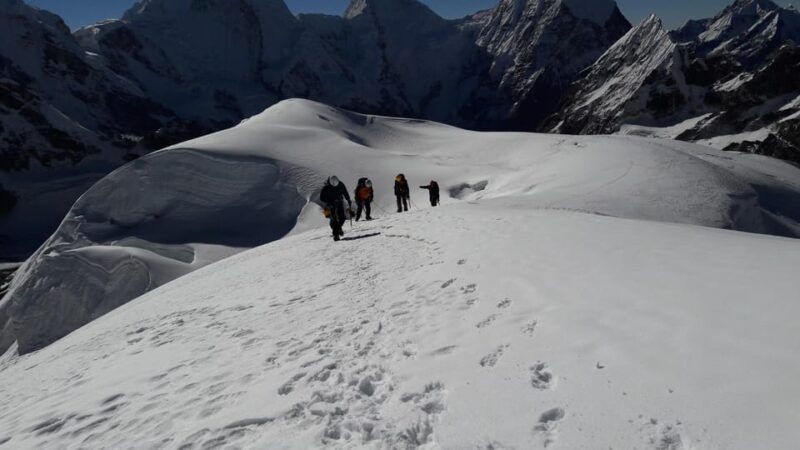
After an early morning flight from Kathmandu to Lukla, the trek through Nepal’s alpine forests and small villages begins.
The roller coaster trail leads the group through rhododendron and pine forests to the Hinku valley. Trekkers will follow this trail, crossing the Chetrawa La pass (4,610m) before returning to Lukla.
Along the way, they’ll witness stunning panoramic views of the surrounding Himalayan peaks, including Everest (8,848m), Lhotse (8,516m), Makalu (8,485m), Kangchenjunga (8,586m), and Cho Oyu (8,201m).
This 13-day journey offers an immersive experience in Nepal’s breathtaking mountain landscapes, providing opportunities for glacier walking, acclimatization, and ultimately, the summit of Mera Peak.
Inclusions and Exclusions
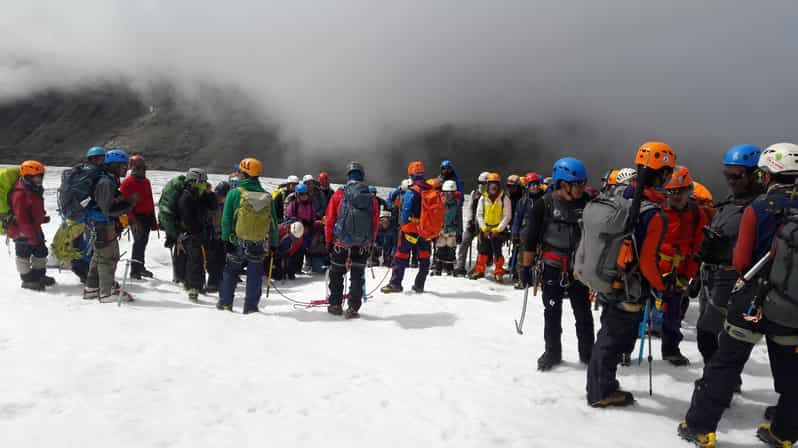
The Mera Peak Climbing expedition includes a comprehensive list of services to support participants throughout their journey. This includes airport transfers, tea house/lodge accommodations, all meals, national park and climbing permits, as well as an experienced guide.
The package also covers a welcome dinner, first aid kit, and flight ticket for the guide. However, it excludes international airfare, hotel stays in Kathmandu, personal expenses, and travel insurance.
Participants will also need to arrange their own trekking/climbing equipment and pay for the flight from Ramechhap to Lukla. Optional porter services can be arranged for an additional fee.
Important Information for Participants
Participants will meet at Tribhuvan International Airport (KTM) in Kathmandu, where they’ll be picked up by a representative.
This trek isn’t suitable for children under 12, pregnant women, or individuals with heart/respiratory issues, altitude sickness, or those over 254 lbs (115 kg).
Recommended gear includes comfortable shoes, warm clothing, hat, camera, snacks, sunscreen, water, gloves, and climbing gear.
Smoking, alcohol, drugs, plastic bottles, glass objects, littering, and touching plants are prohibited.
Experience in glacier walking is recommended, and participants should prepare for varying weather conditions.
Acclimatization days are included in the itinerary.
Tipping is expected for guides, porters, and drivers.
More Great Thing To Do NearbyPreparation and Guidelines
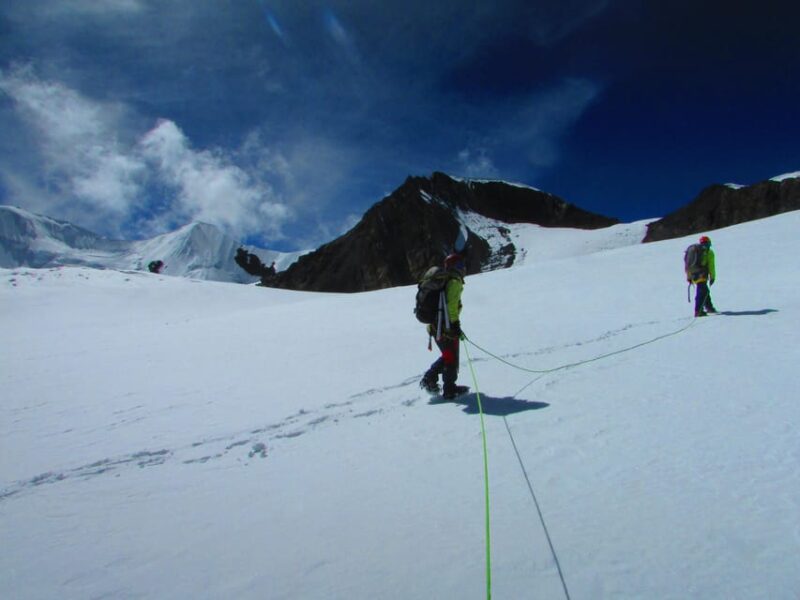
Preparing for the Mera Peak climbing expedition requires prior experience in glacier walking. Climbers should be comfortable using crampons and navigating ropes on snow and ice.
They’ll also need to prepare for varying weather conditions throughout the trek. The itinerary includes acclimatization days to help participants adjust to the high altitude.
It’s important to respect local customs and follow environmental guidelines, such as avoiding littering and not touching plants. Tipping is expected for guides, porters, and drivers who provide exceptional service.
With the right preparation and mindset, adventurers can look forward to the stunning panoramic views from the Mera Peak summit.
Accommodation During the Trek
During the Mera Peak climbing trek, participants typically stay in teahouse/lodge accommodations.
These lodges are basic but comfortable, offering dormitory-style sleeping quarters and shared bathroom facilities. Meals are served in the communal dining areas, providing hearty Nepali and Western fare to fuel trekkers.
The lodges are located at various points along the trail, allowing climbers to rest, recharge, and acclimatize to the high-altitude environment. Bathrooms are typically equipped with running water, though hot water may be limited.
Participants should bring their own sleeping bags and be prepared for basic, yet essential, accommodations throughout the trek to Mera Peak.
Safety and Emergency Protocols
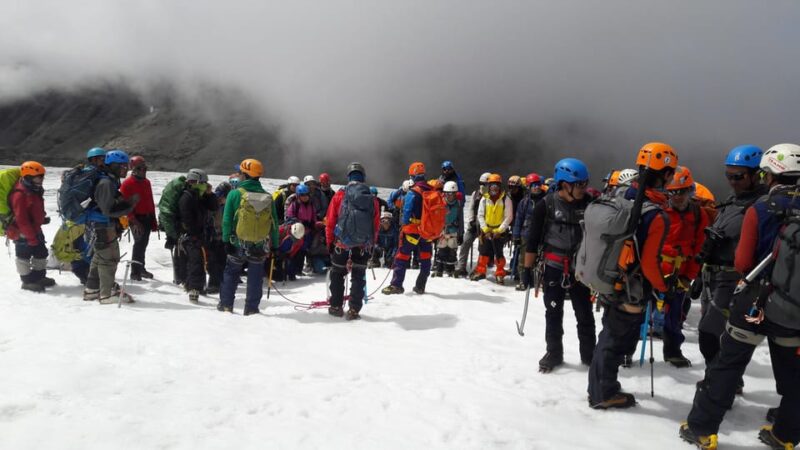
Ensuring the safety of participants is paramount throughout the Mera Peak climbing expedition. All guides are highly experienced and trained in emergency response protocols. They carry comprehensive first aid kits and have access to emergency evacuation services.
Participants are briefed on safety procedures, including proper use of climbing gear and dealing with altitude sickness. In case of medical emergencies, the guides will coordinate with local authorities and arrange for immediate helicopter rescue.
Participants are advised to obtain comprehensive travel insurance covering high-altitude trekking and climbing. With meticulous safety measures in place, climbers can focus on the exhilarating challenge of scaling Mera Peak while minimizing risks.
Recommended Gear and Packing Tips
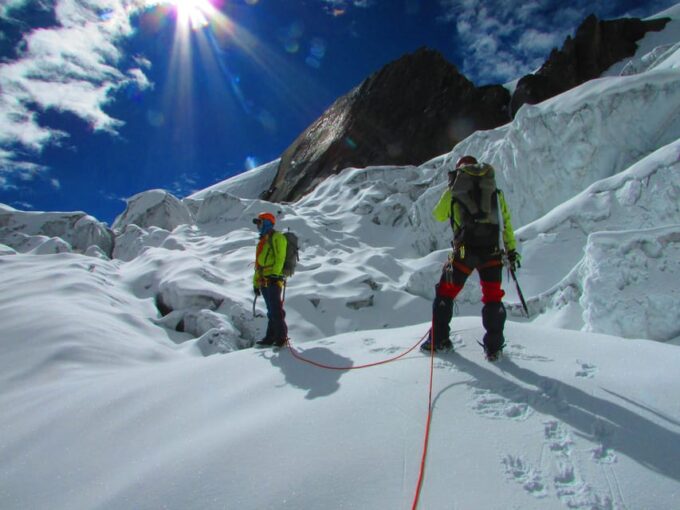
Before embarking on the Mera Peak climbing expedition, trekkers would do well to ensure they have the proper gear to navigate the challenging terrain and unpredictable weather. Proper footwear, warm layers, and protective outerwear are essential. Plus, necessary climbing equipment like ice axes, crampons, and ropes should be packed. To help, here’s a handy packing list:
| Essentials | Clothing | Miscellaneous |
|---|---|---|
| Ice Axe | Base Layers | Sunscreen |
| Crampons | Insulating Mid-Layers | Water Bottle |
| Climbing Harness | Waterproof Jacket/Pants | Snacks |
Trekkers should also consider bringing personal first-aid supplies, navigation tools, and rechargeable batteries. Proper preparation is key to a successful and safe Mera Peak climb.
Frequently Asked Questions
Is There an Option to Hire a Personal Porter for the Trek?
Yes, participants can hire an optional porter for $260 to carry their personal gear during the Mera Peak climbing trek. This provides an extra support for trekkers who prefer not to carry their own equipment.
What Is the Best Time of Year to Attempt the Mera Peak Climb?
The best time to attempt the Mera Peak climb is typically from March to May and September to November. These seasons offer the most favorable weather conditions and clearer views for the challenging ascent.
Can I Extend My Stay in Kathmandu Before or After the Trek?
Yes, participants can extend their stay in Kathmandu before or after the Mera Peak climb. The package doesn’t include hotel accommodations in Kathmandu, so travelers can book additional nights independently to explore the city.
How Much Cash Should I Carry for Personal Expenses During the Trek?
The recommended amount of cash to carry for personal expenses during the Mera Peak trek is around $200-300 USD. This covers items like snacks, drinks, souvenirs, and tips for guides, porters, and drivers.
Is There an Option to Rent Climbing Gear Locally in Kathmandu?
Yes, there are several shops in Kathmandu that rent out climbing gear. Participants can rent items like harnesses, carabiners, crampons, and ice axes locally rather than bringing their own. This can be a cost-effective option for the trek.
Recap
Mera Peak’s breathtaking summit offers unparalleled views of the Himalayan giants. With proper preparation, equipment, and safety protocols in place, adventurers can embark on this thrilling 13-day trek through picturesque landscapes, culminating in a challenging yet immensely rewarding climb to Nepal’s highest trekking peak. The experience promises unforgettable memories and a profound appreciation for the grandeur of the Himalayas.
You can check if your dates are available here:More Tour Reviews in Koshi Zone
Not for you? Here's more things to do in Koshi Zone we have recnetly reviewed
- 4 Best Tours In Koshi Zone
- 4 Best Helicopter Flights And Tours In Koshi Zone
- 4 Best Hiking And Trekking Tours In Koshi Zone
- Private Luxury Everest View 5 Days Heli Tour
- Everest Base Camp Overnight Stay Trek – 15 Days
- Kathmandu Everest Helicopter Tour With Guranteed Landing
- Island Peak (6,189m) Climbing
- Kanchenjunga Circuit Trek – 21 Days
